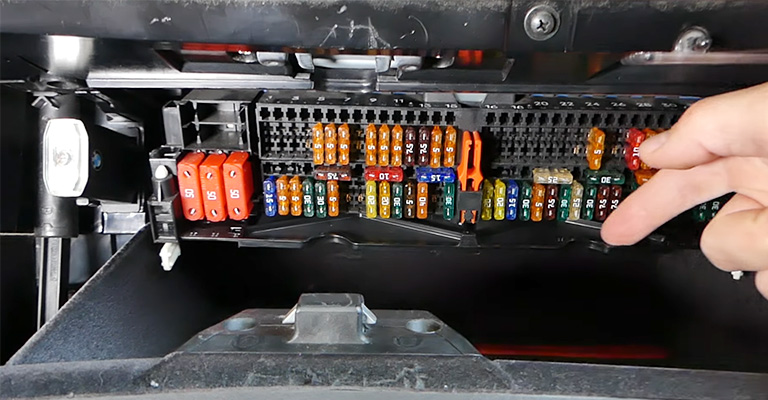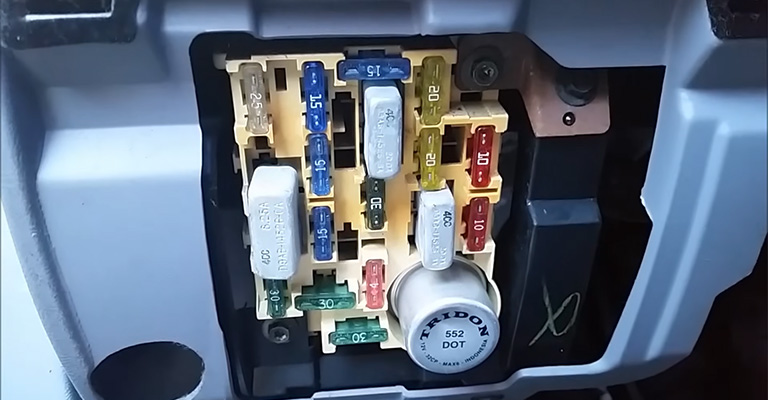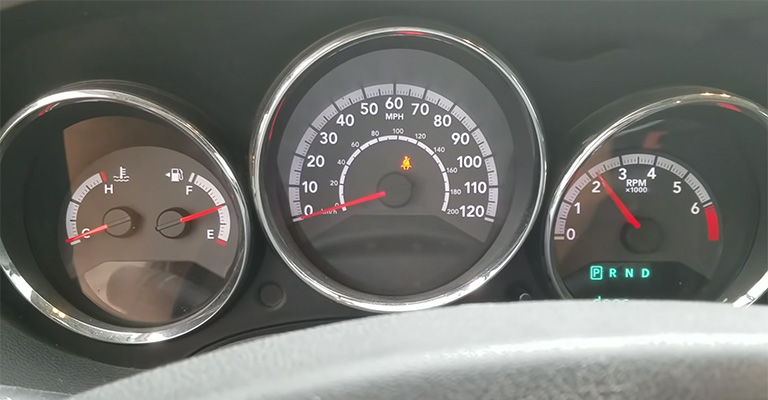You know something is up when your dashboard starts acting like a Christmas tree, with lights flashing and gauges going haywire. And without freaking out, you can try to fix the problem by identifying and replacing the fuse that controls the dashboard gauges.
But what fuse controls the dashboard gauges? The instrument cluster fuse, also known as the dashboard fuse, is responsible for powering the dashboard gauges and displays. If this fuse is blown or damaged, it can cause the gauges and displays to stop working or function improperly.
In this article, we’ll talk about that all-important fuse that controls your dashboard gauges and how to fix it when it’s causing issues.

What Fuse Controls the Dashboard Gauges: Here are the Answers
The instrument cluster fuse, also known as the dashboard fuse, powers the gauges and displays on your vehicle’s dashboard. This includes the speedometer, tachometer, fuel gauge, and temperature gauge.
If this fuse is damaged or blown, it can cause these gauges to stop working or malfunction. For example, your speedometer may not register your speed, or your fuel gauge may not accurately display your fuel level.
Which Fuse Is For The Dashboard Lights?
The speedometer lights on a vehicle are typically controlled by a fuse that is labeled as “instrument cluster” or “gauges” in the fuse box.
The location of the fuse box can vary depending on the make and model of the vehicle, but it is usually located under the dashboard on the driver’s side or in the engine compartment.
You can refer to the owner’s manual of your specific vehicle to locate the fuse box and the fuse that controls the speedometer lights. If you’re looking to replace the dashboard light fuse in your car, you can find it in the fuse box.
The fuse box is usually located either under the car’s hood, beneath the dashboard, or near the glove compartment.
Since there are often many fuses in the box, it can be helpful to check the diagram provided in your car manual or beneath the fuse box cover to locate the specific “dash lights” or “lights” fuse that needs to be replaced.
By doing so, you can quickly and easily replace the blown fuse and restore your dashboard lights to working order.
Dashboard lights are a crucial component of your car’s safety features, and it’s essential to ensure that they are functioning correctly for your vehicle’s overall well-being.
These lights are typically protected by low-amperage (5-7 amps) blade fuses that help safeguard the wiring against short circuits and other electrical overcurrent issues.
A malfunctioning dashboard light caused by a blown fuse can lead to reduced visibility and potential hazards on the road.
Dim or non-functional dashboard lights can make it difficult to identify issues with your car, potentially leading to accidents or further damage to your vehicle.
Regularly replacing blown fuses is an effective way to maintain your dashboard lights and ensure that they are functioning correctly. By doing so, you can help keep yourself and other drivers safe while on the road.
Where is the Instrument Cluster Fuse Located?

The dashboard fuse is typically located in the fuse box of your vehicle. This fuse box is a central hub for all fuses in your vehicle and is located under the dashboard. In some models, it is in the engine compartment.
So, the layout and location of the fuse box can vary depending on the make and model of your vehicle. Therefore, it is always a good idea to consult your owner’s manual or a trusted mechanic for specific instructions on locating it.
To find this specific fuse, you need to look for a diagram or label inside the box indicating which fuse corresponds to which circuit. The instrument cluster fuse will typically be labeled with a description such as “dashboard,” “instrument cluster,” or “gauges.”
Signs your Dashboard Gauge Fuse is Broken or Blown
If you suspect your dashboard gauge fuse may be blown, here are a few signs to look out for
1. Unresponsive Gauges

As mentioned earlier, the instrument cluster fuse is responsible for providing power to the various components of your dashboard. It powers the speedometer, tachometer, fuel gauge, and temperature gauge.
If this fuse is damaged or blown, it can cause the gauges to stop working completely.
2. Warning Lights Stop Functioning
The instrument cluster fuse is responsible for providing power to the various components of your dashboard, including the warning lights. If this fuse is damaged or blown, it can cause the warning lights to stop working.
It is essential to note that other issues can cause your warning lights to stop functioning as well. You could have a malfunctioning sensor or a problem with the electrical system. However, there are several ways to determine if your warning lights are not functioning due to a blown dashboard fuse.
One way is to check the other gauges and displays on your dashboard to see if they are also not functioning. If all of the gauges and displays on your dashboard are not working, the issue is likely related to the instrument cluster fuse.
3. Other Electrical Components Stop Functioning

When you have a major problem in your vehicle, other electricals will also stop functioning. That includes your dashboard gauges, wipers and other things. Their fuses could be damaged just as your dashboard gauge fuse.
Another possibility is that your vehicle’s battery may be damaged, which can cause all of the electrical components in your vehicle to stop functioning.
4. Erratic Behavior
If you’re noticing strange and erratic behavior from your dashboard, it could be a sign that your dashboard fuse has gone bad.
This can manifest in a variety of ways. The signs include the speedometer spinning wildly, the fuel gauge fluctuating erratically, or the temperature gauge behaving unpredictably. Essentially, it’s like your dashboard is having a breakdown right in front of you while you’re driving.
What Causes the Dashboard Gauge Fuse to Break Down?
Here are the things that will make your dashboard fuse blow:
1. Short Circuits

A short circuit occurs when an electrical circuit has an unintended connection between two points. This can cause excessive current flow through the circuit, leading to the fuse blowing.
2. Improper Dashboard Fuse Replacements
If you use gauges or lights that are not manufactured for your car model, they could cause the fuse to blow. Also, if you use a fuse with a low amperage rating, it could blow out after a few rides.
3. Wrong Wiring
If the wiring leading to the dashboard gauge fuse is incorrect, it can cause an electrical issue that could lead to the fuse blowing. This could be due to a wiring error during installation or result from damage to the wiring over time.
4. Age
Like anything else, fuses can wear out over time. If a dashboard gauge fuse has been in use for an extended period of time, it may simply break down due to age.
5. Corrosion

If the fuse is exposed to corrosive substances, it can break down. This could be due to exposure to water or other chemicals, which can cause corrosion on the fuse and interfere with its ability to function properly.
6. Electrical Overload
An electrical overload occurs when too much current flows through a circuit. This can be caused by a malfunctioning gauge electrical component drawing too much power. If the electrical overload is severe enough, it can cause the fuse to blow.
How to Replace the Dashboard Gauge Fuse
To replace your dashboard Gauge, follow the steps below:
Step 1. Locate the Fuse and Inspect it
As mentioned earlier, this fuse is located inside your fuse box. Locate it and remove it. Use a fuse puller or a pair of needle-nose pliers to carefully remove the faulty fuse from the fuse panel.
However, to inspect whether it is faulty, you need to use a multimeter. Here’s how to use a multimeter to test a dashboard gauge fuse:
- Set the multimeter to the “resistance” or “ohms” setting: This setting allows the multimeter to measure the resistance of the circuit.
- Connect the leads: Connect the red lead to one end of the fuse and the black lead to the other.
- Read the measurement: If the fuse is good, the multimeter should display a zero or low resistance reading. If the reading is higher, the fuse is faulty and needs to be replaced.
You should also test if the fuse has a complete circuit. It can display zero ohms if its circuit is not complete. Here’s how to use a continuity test to test a dashboard gauge fuse:
- Set the multimeter to the “continuity” setting: This allows the multimeter to determine whether or not a circuit is complete.
- Connect the leads: Connect the red lead to one end of the fuse and the black lead to the other end.
- Test the fuse: If the fuse is good, the multimeter will beep, indicating that the circuit is complete. If the fuse is faulty, the multimeter will not beep, indicating that the circuit is incomplete.
Step 2. Replace the Fuse
Start by wearing gloves and eye protection and ensuring the vehicle’s battery is disconnected before working on the fuse panel. Install a new fuse of the same type and rating as the faulty fuse. Ensure the fuse is fully seated in the fuse panel and the end caps are in place.
Step 3. Test the Gauges
Here is how to test whether you have fixed the problem:
- Begin with the ignition on: Before checking the gauges, ensure the vehicle’s ignition is turned on, but don’t start the engine yet.
- Look at the gauges: Once the ignition is on, look at the gauges on the dashboard. They should be in the correct positions and reading correctly.
- Verify the warning lights: Check that all the warning lights on the dashboard are functioning properly. These lights should turn on and off as needed, depending on the status of the vehicle’s systems.
- Test the dashboard lights: Ensure the lights, such as turn signals, are working properly. Depending on the ambient light level, they should turn on and off as needed.
FAQs
Here are answers to common questions about the dashboard gauge fuse:
What Should I Do If Changing the Fuse Doesn’t Fix the Problem?
Start by checking whether you have other faulty electrical components. Test your battery and all the major fuses. Also, check for wiring damages and grounding issues.
How Do I Replace Dashboard Gauge Lights?
Remove the gauge panel to access the back of the gauge, identify the faulty light, and remove it. Next, install a new light of the same type and rating, and reattach the gauge panel. Ensure that you follow proper safety precautions, including disconnecting the battery to avoid electrical hazards.
Conclusion
The above information has put to bed your question about what fuse controls the dashboard gauges. To prevent future dashboard fuse damage, use the correct fuse and handle it carefully. Regularly check and replace old or worn-out fuses, and keep the fuse away from corrosive substances.
Additionally, check the wiring and connections leading to the dashboard gauge fuse to ensure they are in good condition and securely connected. If you encounter any difficulties or are unsure about how to handle dashboard fuse damage, it’s best to seek the help of a professional mechanic.

Leave a Reply